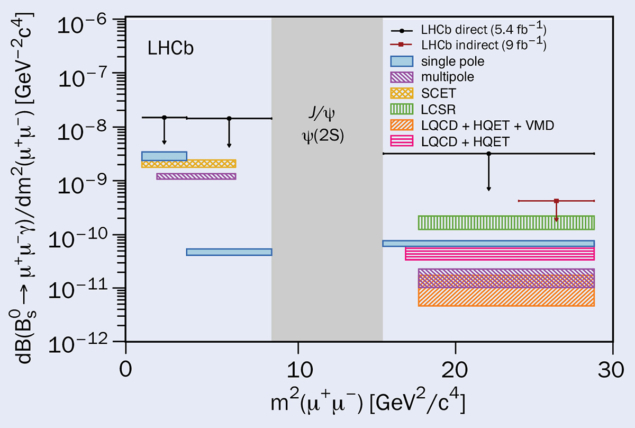A report from the LHCb experiment.

Rare radiative b-hadron decays are powerful probes of the Standard Model (SM) sensitive to small deviations caused by potential new physics in virtual loops. One such process is the decay of B0s → μ+μ–γ. The dimuon decay of the B0s meson is known to be extremely rare and has been measured with unprecedented precision by LHCb and CMS. While performing this measurement, LHCb also studied the B0s → μ+μ–γ decay, partially reconstructed due to the missing photon, as a background component of the B0s → μ+μ– process and set the first upper limit on its branching fraction to 2.0 × 10–9 at 95% CL (red arrow in figure 1). However, this search was limited to the high-dimuon-mass region, whereas several theoretical extensions of the SM could manifest themselves in lower regions of the dimuon-mass spectrum. Reconstructing the photon is therefore essential to explore the spectrum thoroughly and probe a wide range of physics scenarios.
The LHCb collaboration now reports the first search for the B0s → μ+μ–γ decay with a reconstructed photon, exploring the full dimuon mass spectrum. Photon reconstruction poses additional experimental challenges, such as degrading the mass resolution of the B0s candidate and introducing additional background contributions. To cope with this ambitious search, machine-learning algorithms and new variables have been specifically designed with the aim of discriminating the signal among background processes with similar signatures. The analysis is performed separately for three dimuon mass ranges to exploit any differences along the spectrum, such as the ϕ(1020) meson contribution in the low invariant mass region. The μ+μ–γ invariant mass distributions of the selected candidates are fitted, including all background contributions and the B0s → μ+μ–γ signal component. Figure 2 shows the fit for the lowest dimuon mass region.

No significant signal of B0s → μ+μ–γ is found in any of the three dimuon mass regions, consistent with the background-only hypothesis. Upper bounds on the branching fraction are set and can be seen as the black arrows in figure 1. The mass fit is also performed for the combined candidates of the three dimuon mass regions to set a combined upper limit on the branching fraction to 2.8 × 10–8 at 95% CL.
The SM theoretical predictions of b decays becomes particularly difficult to calculate when a photon is involved, and they have large uncertainties due to the B0s → γ local form factors. The B0s → μ+μ–γ decay provides a unique opportunity to validate the different theoretical approaches, which do not agree with each other, as shown by the coloured bands in figure 1. Theoretical calculations of the branching fractions are currently below the experimental limits. The upgraded LHCb detector and the increased luminosity of the LHC’s Run 3 is currently providing conditions for studying rare radiative b-hadron decays with greater precision and, eventually, for finding evidence for the B0s → μ+μ–γ decay.
Further reading
LHCb Collab 2024 arXiv:2404.03375.







